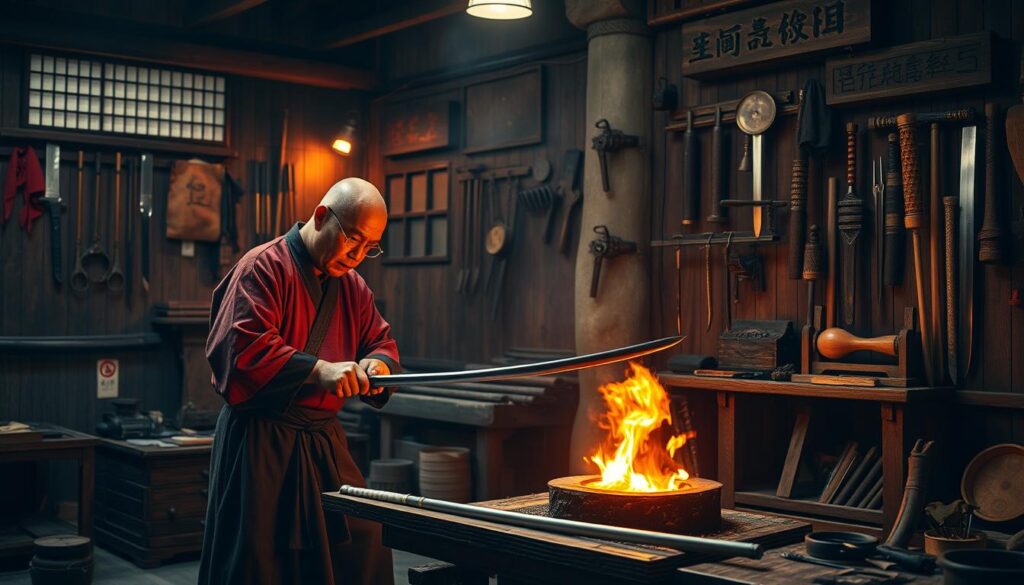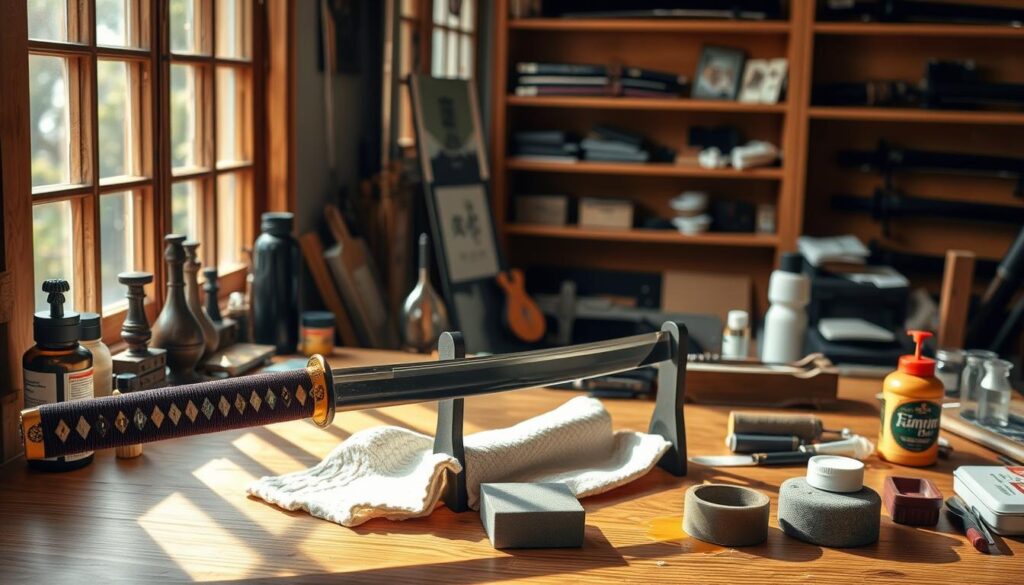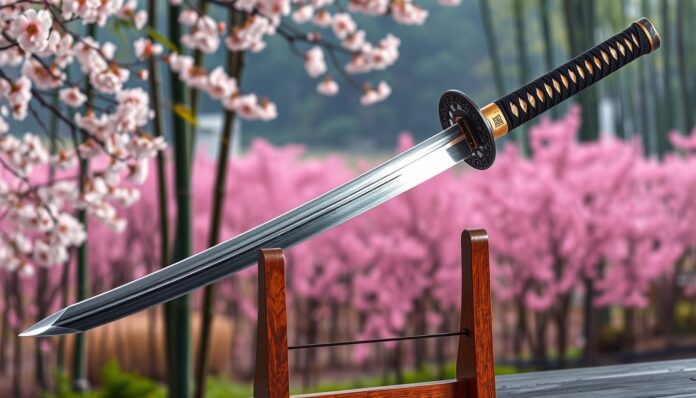The katana sword is not just any weapon. It’s a deep symbol of Japanese culture and heritage. Its elegance and efficiency show the samurai warrior’s spirit. The story of each hand-forged blade is one of dedication, artistry, and history. This guide looks closely at katana ownership, its rich history, and how to care for this art piece. Knowing about the katana’s past and how to look after it will make you value it even more.
Key Takeaways
- The katana sword symbolizes Japanese culture and craftsmanship.
- Each blade reflects the skill and dedication of the swordsmith.
- Understanding the history of the katana enhances ownership appreciation.
- Katana ownership requires proper maintenance to preserve its beauty.
- The Japanese samurai sword has played a significant role in martial traditions.
Introduction to the Katana Sword
The katana sword is a symbol of the bravery and skill of the Japanese samurai. It has a unique curved blade. It is not just practical but also shows centuries of Japanese craftsmanship. The katana combines use and beauty, loved by martial artists and collectors.
Making a katana requires great skill and patience from the swordsmith. Each blade represents the samurai’s spirit. It has a sharp edge and a grip for fast moves. This makes the katana different from other swords like the straight tachi or the European longsword.
- Curved Blade: The design allows for effective slicing motions.
- Single Edge: Focused on cutting rather than thrusting.
- Length: Ideal for mobility and quick drawing.
- Handle Design: Crafted for comfort during use.
The katana is more than a weapon. It shows the samurai’s spiritual path. Its elegant shape and decorations show traditional Japanese artistry. It links the blade and the warrior, making the katana a deeply meaningful cultural piece.
The Rich History of the Katana Sword
The katana sword has a deep history, emerging from Japan. Its journey began in the Heian period (794-1185), where its unique design started to form. This early katana had a curved blade, different from previous straight swords. It was made for quick, effective slashing.
In the Kamakura period (1185-1333), the katana grew close to the samurai. The samurai class pushed for better craftsmanship, mixing art with functionality. The sword became more than a weapon; it symbolized honor and status.
Zen Buddhism played a big role in how katanas were made. Craftsmen, called tosho, aimed for perfection, following the spiritual path of discipline. Their innovations made the katana legendary.
Important people in Japan’s history favored the katana in battles, like those in the Sengoku period (1467-1603). Heroes such as Minamoto no Yoshitsune showed its value in combat.
During the Edo period (1603-1868), Japan was peaceful, but the katana remained important. It shifted from being a battle tool to a valued artifact. Nowadays, it’s a symbol of Japan’s traditional artistry.
Understanding Traditional Japanese Craftsmanship
Traditional Japanese craftsmanship combines art and precision, seen in sword making. The katana, a symbol of this craft, reflects knowledge shared by artisans for centuries. It showcases their commitment and detailed process.
The Art of Sword Smithing
Sword making is an art that calls for patience and a focus on detail. Master swordsmiths use special techniques with tamahagane steel from iron sand. This steel is key for the katana’s strength and sharpness.
During forging, the steel is heated and folded many times. This process removes impurities and boosts its strength.
- Folding technique: Involves layering and hammering the steel to enhance its properties.
- Quenching: Rapid cooling in water or oil strengthens the blade and defines its edge.
- Shaping: The blade is carefully formed to create the distinctive curvature known as “sori.”
Historical Techniques in Forge Production
Learning about ancient forge techniques sheds light on this old craft. Early smiths’ methods are the basis for today’s techniques. They used bamboo charcoal forges to achieve consistent heat, crucial for molding and shaping. These techniques stress the significance of traditional Japanese craftsmanship in making genuine katana swords.
| Technique | Description | Impact on Blade |
|---|---|---|
| Folding | Layering steel to redistribute impurities. | Improved strength and flexibility. |
| Quenching | Rapid cooling to harden the blade. | Enhanced sharpness and durability. |
| Shaping | Forming the blade’s curvature and tang. | Optimal balance and handling. |

Features of a Hand-Forged Katana Blade
A hand-forged katana blade stands out because of its unique features. Its curve, or sori, improves its slicing power. This design also adds to the sword’s beauty and makes it more effective when used.
The tang, also called nakago, goes into the hilt. It helps with balance and control, so you can handle the sword precisely. The blade’s edge, or ha, is made to be both strong and sharp. These katana features highlight the care taken in making the sword.
Using folded steel is key to a blade’s strength and bendability. The steel is layered and hammered. This creates a blade that doesn’t easily break or bend. The unique patterns, or hada, add beauty and are practical too.
Putting these elements together makes the katana both useful and collectible. Knowing about these features shows why hand-forged katanas are valued for their traditional craftsmanship.
The Importance of Folded Steel in Katana Construction
Folded steel is key in making katanas strong and durable. The process of folding steel gets rid of impurities, making the metal purer. This is crucial for the blade’s strength.
When making a katana, folding the steel over and over adds many layers. These layers make the blade both tough and flexible. So, swords made this way can handle a lot during usage, proving to be both practical and dependable.
A folded steel katana also looks amazing. The folding pattern can look like water or waves. This beauty in design makes the sword more valuable, not just for use but also as a piece of art. Therefore, both collectors and martial artists love these swords for their unique look.
- Improved Structural Integrity: The removal of impurities leads to a more resilient blade.
- Enhanced Toughness: Layering contributes to the sword’s ability to withstand impact.
- Aesthetic Value: Unique patterns create visually stunning blades.
The tradition of using folded steel in katana making is important. It combines beauty with performance in every blade crafted. This technique’s longevity shows its value and quality.
Maintaining Your Katana Sword
Taking care of a katana sword needs both focus and patience. This helps keep its beauty and usefulness. Everyone, from seasoned collectors to newbies, must learn how to handle their sword well.
Essential Sword Maintenance Tips
Maintaining your katana means doing frequent cleaning and checks. To ensure your sword stays in great condition, follow these tips:
- Clean after each use: Use a soft cloth to wipe off fingerprints, dirt, and moisture from the blade.
- Apply oil: A good sword oil is key to prevent rust by keeping the blade lubricated.
- Check for damage: Always inspect the blade for any chips, cracks, or rust.
- Hone the edge: Keeping it sharp will ensure the sword performs well and lasts longer.
How to Store Your Katana Safely
Correct storage is vital to avoid damage to your katana. Below are some effective ways to store it safely:
- Use a quality saya: A strong scabbard will shield the blade from the elements.
- Control the climate: A climate-controlled space helps prevent damage from humidity and temperature changes.
- Avoid direct sunlight: Keeping the katana out of direct sun prevents fading and damage.
- Display with care: When on display, use a sturdy case to reduce the chance of damage.

The Role of the Katana in Martial Arts Weapons
The katana holds a special place in martial arts. It’s important in traditions that value the old ways. Its shape and sharp edge are perfect for many uses, like kendo and iaido. Learning the katana helps improve fighting skills, discipline, and respect for the art.
In kendo, fighters spar and train with shinai, bamboo swords. These mimic the katana. This keeps the katana central in martial arts as a key training tool. Japanese sword techniques grow through practice and duels. This boosts speed, accuracy, and strategic thinking.
Iaido focuses on pulling out and slicing with the katana. It pairs mental focus with physical action, linking swordsmen with their blades. Iaido’s practices spotlight the value of form and skill, making the katana perfect for honing abilities.
The katana’s impact goes beyond its form; it influences martial arts’ culture and philosophy. Mastering the katana brings a sense of history and tradition. It connects students with ancient warriors. This keeps the katana’s legacy vibrant, turning it into a symbol of martial excellence.
| Martial Art | Focus | Use of Katana |
|---|---|---|
| Kendo | Sparring and competition | Symbolic connection with katana through shinai |
| Iaido | Drawing techniques and forms | Direct practice with the katana |
| Kenjutsu | Traditional sword techniques | Combat training with actual katana |
These disciplines show the katana’s varied role in martial arts. Each method honors the weapon’s heritage. This ensures its importance stays alive in today’s martial arts.
Katana Swords as Collectors’ Items
Katana swords are more than just weapons. They are prized collectibles that charm fans with their beauty and artistry. The katana sword value changes a lot, depending on a few key things. Collectors should keep these in mind.
The age of a sword matters a lot; older ones can be quite costly. This is especially true for swords from important historical times. The way a sword is made also affects its value a lot. Swords with intricate details and made with great skill are more sought after. The history behind a katana can also make it much more valuable.
Swords with special features, like unique designs, really stand out. Collectors often prefer historical swords they can trace back through history. Making sure a sword is genuine is very important. This means buyers must do their homework well.
Talking with other collectors can offer tips on buying and valuing these amazing items. Some auctions feature rare swords and draw a lot of interest. By learning about these things, collectors can make smart choices. They can also enjoy the rich history each sword carries.
| Factor | Impact on Value |
|---|---|
| Age | Older swords, particularly from the Edo period, tend to be more valuable. |
| Craftsmanship | Expertly made swords with intricate designs are highly coveted. |
| Historical Significance | Swords linked to influential figures or events can fetch higher prices. |
| Provenance | Documented ownership history enhances the sword’s appeal. |
| Unique Features | Swords with distinctive elements or custom fittings are often more valuable. |
Conclusion
The katana isn’t just any sword; it’s rich in tradition and art. We’ve delved into its fascinating history in this guide. Every part of the katana tells a story, showing us the blade’s significance. Knowing its past lets us appreciate the skill and hard work needed to make it. This shows why the katana is a key symbol of Japanese culture.
Taking care of your katana is crucial. Proper upkeep keeps the sword in good shape and respects its history. By polishing and storing it right, and handling it carefully, you keep your katana looking great. This way, others can admire its beauty for years to come.
In short, the katana is more than just a weapon; it’s a historical treasure. Recognizing its cultural value and caring for it means you’re part of its long-standing tradition. Owning a katana comes with great respect and pride. Embrace this journey and honor the katana’s rich legacy.
